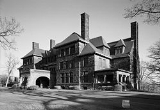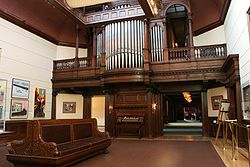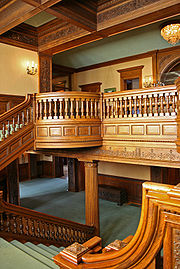
James J. Hill House
Encyclopedia
The James J. Hill House, in Saint Paul, Minnesota
, was built by railroad magnate James J. Hill
. The house, completed in 1891, is near the eastern end of Summit Avenue near the Cathedral of Saint Paul
. The house, for its time, was very large and was the "showcase of St. Paul" until James J. Hill's death in 1916. It is listed as a U.S. National Historic Landmark
.
With 36,000 square feet (3,344 square meters) of living area, the house is the largest residence in Minnesota
.
area, making it a highly desirable location. The family previously lived in the Lowertown area in St. Paul, near Ninth and Canada streets. As new warehouses and railroad tracks crowded the Lowertown residential area, and as Hill's collection of paintings and sculpture overflowed the house, the Hill family thought it was desirable to move. Hill also realized that recent improvements in home technology, such as electric lighting, plumbing, ventilation, and fireproofing, could be incorporated into a new home. Moreover, since Hill was becoming a socially prominent person in the community, a new home would stand as a tribute to his status as the "Empire Builder".
The house was designed by an East Coast architectural firm, Peabody, Stearns and Furber
, at a time when other homes in the neighborhood were designed by local architects such as Clarence Johnston and Cass Gilbert
. The house was designed in the Richardsonian Romanesque
style, with a massive, rugged style featuring randomly sized blocks of stone, sturdy pillars, rounded arches, and a generally strong horizontal emphasis. Hill supervised the design and construction closely. As an example, when the Lewis Comfort Tiffany Company submitted designs for the stained glass windows, Hill replied that they were, "anything but what I want," and the job went to A.B. Cutter and Company of Boston. Later, in 1889, Hill fired the architects because they had overridden his orders to the stonecutters in Massachusetts
, and hired the Boston firm of Irving and Casson to finish the project. The St. Paul Pioneer Press
reviewed the house just before it was completed in 1891, saying:
 The interior features an art gallery that housed Hill's collection of painting and sculpture. It even had a pipe organ, installed after someone suggested to Hill that other wealthy people had pipe organs in their homes. The house had a hybrid system of gas
The interior features an art gallery that housed Hill's collection of painting and sculpture. It even had a pipe organ, installed after someone suggested to Hill that other wealthy people had pipe organs in their homes. The house had a hybrid system of gas
and electric
lighting, with rotary switches on the walls to turn on the electric lights. However, there were no electrical outlets installed, because during that era electricity was only used for lighting. The woodwork in the house is very intricate, with hand-carved woodworking in the central hallway, the formal dining room, and the music room. Other rooms in the house, particularly on the second floor where most of the family members lived, do not have hand carved woodwork, but the woodwork is still richly colored and nicely detailed.
 The first floor, in addition to the art gallery, music room, hall, and formal dining room previously mentioned, also had a library, a drawing room, and Mr. Hill's home office. The second floor contained Mr. and Mrs. Hill's rooms, two guest rooms, and rooms for their five daughters, Gertrude, Rachel, Clara, Ruth, and Charlotte. The third floor contained rooms for their sons James, Walter, and Louis (who later succeeded his father as president of the Great Northern Railway). It also had a room that served as a gymnasium and school room for the children, as well as quarters for the servants.
The first floor, in addition to the art gallery, music room, hall, and formal dining room previously mentioned, also had a library, a drawing room, and Mr. Hill's home office. The second floor contained Mr. and Mrs. Hill's rooms, two guest rooms, and rooms for their five daughters, Gertrude, Rachel, Clara, Ruth, and Charlotte. The third floor contained rooms for their sons James, Walter, and Louis (who later succeeded his father as president of the Great Northern Railway). It also had a room that served as a gymnasium and school room for the children, as well as quarters for the servants.
. The church used it for the next fifty-three years as space for offices, residences, and a teacher's college for women. Fortunately, the church preserved it well and did not make any significant alterations, although most of the original furniture was sold during this period. In 1961, the United States Department of the Interior
designated the house a National Historic Landmark
. The Minnesota Historical Society
acquired the house in 1978, after the Archdiocese consolidated its offices elsewhere. The house has been restored and is now open for tours.
Saint Paul, Minnesota
Saint Paul is the capital and second-most populous city of the U.S. state of Minnesota. The city lies mostly on the east bank of the Mississippi River in the area surrounding its point of confluence with the Minnesota River, and adjoins Minneapolis, the state's largest city...
, was built by railroad magnate James J. Hill
James J. Hill
James Jerome Hill , was a Canadian-American railroad executive. He was the chief executive officer of a family of lines headed by the Great Northern Railway, which served a substantial area of the Upper Midwest, the northern Great Plains, and Pacific Northwest...
. The house, completed in 1891, is near the eastern end of Summit Avenue near the Cathedral of Saint Paul
Cathedral of Saint Paul (Minnesota)
The Cathedral of Saint Paul is a Roman Catholic cathedral in the city of St. Paul, Minnesota. It is the Co-Cathedral of the Archdiocese of Saint Paul and Minneapolis, along with the Basilica of St. Mary in Minneapolis. One of the most distinctive cathedrals in the United States, it sits on...
. The house, for its time, was very large and was the "showcase of St. Paul" until James J. Hill's death in 1916. It is listed as a U.S. National Historic Landmark
National Historic Landmark
A National Historic Landmark is a building, site, structure, object, or district, that is officially recognized by the United States government for its historical significance...
.
With 36,000 square feet (3,344 square meters) of living area, the house is the largest residence in Minnesota
Minnesota
Minnesota is a U.S. state located in the Midwestern United States. The twelfth largest state of the U.S., it is the twenty-first most populous, with 5.3 million residents. Minnesota was carved out of the eastern half of the Minnesota Territory and admitted to the Union as the thirty-second state...
.
History
Hill bought two lots on Summit Avenue in 1882, during an era when wealthy citizens were scrambling to build fashionable homes in the neighborhood. The street offered a commanding view of downtown St. Paul and the Mississippi RiverMississippi River
The Mississippi River is the largest river system in North America. Flowing entirely in the United States, this river rises in western Minnesota and meanders slowly southwards for to the Mississippi River Delta at the Gulf of Mexico. With its many tributaries, the Mississippi's watershed drains...
area, making it a highly desirable location. The family previously lived in the Lowertown area in St. Paul, near Ninth and Canada streets. As new warehouses and railroad tracks crowded the Lowertown residential area, and as Hill's collection of paintings and sculpture overflowed the house, the Hill family thought it was desirable to move. Hill also realized that recent improvements in home technology, such as electric lighting, plumbing, ventilation, and fireproofing, could be incorporated into a new home. Moreover, since Hill was becoming a socially prominent person in the community, a new home would stand as a tribute to his status as the "Empire Builder".
The house was designed by an East Coast architectural firm, Peabody, Stearns and Furber
Peabody and Stearns
Peabody & Stearns was a premier architectural firm in the Eastern United States in the late 19th century and early 20th century. Based in Boston, Massachusetts, the firm consisted of Robert Swain Peabody and John Goddard Stearns, Jr...
, at a time when other homes in the neighborhood were designed by local architects such as Clarence Johnston and Cass Gilbert
Cass Gilbert
- Historical impact :Gilbert is considered a skyscraper pioneer; when designing the Woolworth Building he moved into unproven ground — though he certainly was aware of the ground-breaking work done by Chicago architects on skyscrapers and once discussed merging firms with the legendary Daniel...
. The house was designed in the Richardsonian Romanesque
Richardsonian Romanesque
Richardsonian Romanesque is a style of Romanesque Revival architecture named after architect Henry Hobson Richardson, whose masterpiece is Trinity Church, Boston , designated a National Historic Landmark...
style, with a massive, rugged style featuring randomly sized blocks of stone, sturdy pillars, rounded arches, and a generally strong horizontal emphasis. Hill supervised the design and construction closely. As an example, when the Lewis Comfort Tiffany Company submitted designs for the stained glass windows, Hill replied that they were, "anything but what I want," and the job went to A.B. Cutter and Company of Boston. Later, in 1889, Hill fired the architects because they had overridden his orders to the stonecutters in Massachusetts
Massachusetts
The Commonwealth of Massachusetts is a state in the New England region of the northeastern United States of America. It is bordered by Rhode Island and Connecticut to the south, New York to the west, and Vermont and New Hampshire to the north; at its east lies the Atlantic Ocean. As of the 2010...
, and hired the Boston firm of Irving and Casson to finish the project. The St. Paul Pioneer Press
St. Paul Pioneer Press
The St. Paul Pioneer Press is a newspaper based in St. Paul, Minnesota, primarily serving the Twin Cities metropolitan area. Circulation is heaviest in the eastern metro region, including Ramsey, Dakota, and Washington counties, along with western Wisconsin, eastern Minnesota and Anoka County,...
reviewed the house just before it was completed in 1891, saying:
Solid, substantial, roomy, and comfortable is the new home of James J. Hill and family. ... There has been no attempt at display, no desire to flaunt an advertisement of wealth in the eyes of the world. Just a family home... impressive, fine, even grand in the simplicity of design, but after all a St. Paul home.
Interior

Gas lighting
Gas lighting is production of artificial light from combustion of a gaseous fuel, including hydrogen, methane, carbon monoxide, propane, butane, acetylene, ethylene, or natural gas. Before electricity became sufficiently widespread and economical to allow for general public use, gas was the most...
and electric
Electric light
Electric lights are a convenient and economic form of artificial lighting which provide increased comfort, safety and efficiency. Most electric lighting is powered by centrally-generated electric power, but lighting may also be powered by mobile or standby electric generators or battery systems...
lighting, with rotary switches on the walls to turn on the electric lights. However, there were no electrical outlets installed, because during that era electricity was only used for lighting. The woodwork in the house is very intricate, with hand-carved woodworking in the central hallway, the formal dining room, and the music room. Other rooms in the house, particularly on the second floor where most of the family members lived, do not have hand carved woodwork, but the woodwork is still richly colored and nicely detailed.

Later history
After James J. Hill died in 1916 and his wife died in 1921, the children eventually moved out. In 1925, four of the daughters purchased the house from the estate and donated it to the Roman Catholic Archdiocese of Saint Paul and MinneapolisRoman Catholic Archdiocese of Saint Paul and Minneapolis
The Roman Catholic Archdiocese of Saint Paul and Minneapolis is an ecclesiastical territory or diocese of the Catholic Church in the United States. It is led by the prelature of an archbishop which administers the archdiocese from the cities of Saint Paul and Minneapolis...
. The church used it for the next fifty-three years as space for offices, residences, and a teacher's college for women. Fortunately, the church preserved it well and did not make any significant alterations, although most of the original furniture was sold during this period. In 1961, the United States Department of the Interior
United States Department of the Interior
The United States Department of the Interior is the United States federal executive department of the U.S. government responsible for the management and conservation of most federal land and natural resources, and the administration of programs relating to Native Americans, Alaska Natives, Native...
designated the house a National Historic Landmark
National Historic Landmark
A National Historic Landmark is a building, site, structure, object, or district, that is officially recognized by the United States government for its historical significance...
. The Minnesota Historical Society
Minnesota Historical Society
The Minnesota Historical Society is a private, non-profit educational and cultural institution dedicated to preserving the history of the U.S. state of Minnesota. It was founded by the territorial legislature in 1849, almost a decade before statehood. The Society is named in the Minnesota...
acquired the house in 1978, after the Archdiocese consolidated its offices elsewhere. The house has been restored and is now open for tours.
External links
- James J. Hill House, Minnesota Historical Society.
- James J. Hill House Phototour from The Minnesota Historical Society on Flickr.
- Minnesota History Quarterly: The James Hill House: Symbol of Status and Security (Summer 1997)
- NHL summary

